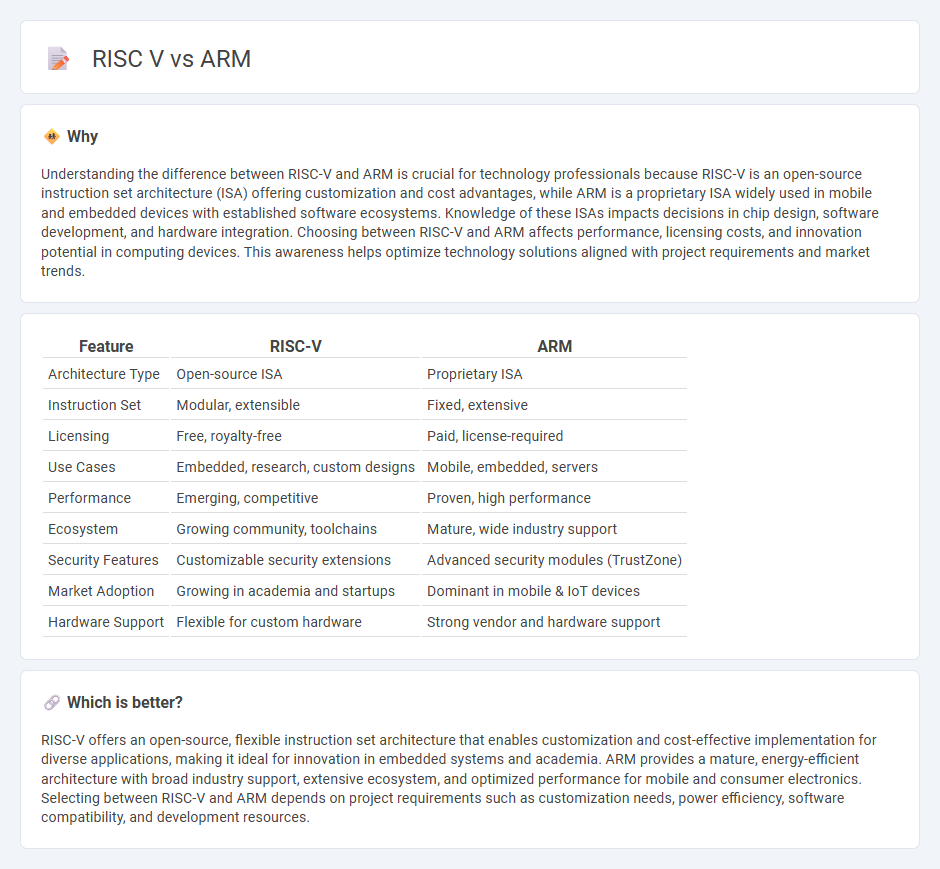
RISC-V and ARM are two leading instruction set architectures (ISAs) in modern computing, with RISC-V being an open-source ISA designed for scalability and customization, while ARM is a proprietary ISA widely used in mobile and embedded devices due to its power efficiency and extensive ecosystem. The open nature of RISC-V offers flexibility for innovation and cost reduction in hardware design, contrasting with ARM's established market dominance and comprehensive software support. Explore the detailed comparison of RISC-V and ARM architectures to understand their impact on the future of technology.
Why it is important
Understanding the difference between RISC-V and ARM is crucial for technology professionals because RISC-V is an open-source instruction set architecture (ISA) offering customization and cost advantages, while ARM is a proprietary ISA widely used in mobile and embedded devices with established software ecosystems. Knowledge of these ISAs impacts decisions in chip design, software development, and hardware integration. Choosing between RISC-V and ARM affects performance, licensing costs, and innovation potential in computing devices. This awareness helps optimize technology solutions aligned with project requirements and market trends.
Comparison Table
| Feature | RISC-V | ARM |
|---|---|---|
| Architecture Type | Open-source ISA | Proprietary ISA |
| Instruction Set | Modular, extensible | Fixed, extensive |
| Licensing | Free, royalty-free | Paid, license-required |
| Use Cases | Embedded, research, custom designs | Mobile, embedded, servers |
| Performance | Emerging, competitive | Proven, high performance |
| Ecosystem | Growing community, toolchains | Mature, wide industry support |
| Security Features | Customizable security extensions | Advanced security modules (TrustZone) |
| Market Adoption | Growing in academia and startups | Dominant in mobile & IoT devices |
| Hardware Support | Flexible for custom hardware | Strong vendor and hardware support |
Which is better?
RISC-V offers an open-source, flexible instruction set architecture that enables customization and cost-effective implementation for diverse applications, making it ideal for innovation in embedded systems and academia. ARM provides a mature, energy-efficient architecture with broad industry support, extensive ecosystem, and optimized performance for mobile and consumer electronics. Selecting between RISC-V and ARM depends on project requirements such as customization needs, power efficiency, software compatibility, and development resources.
Connection
RISC-V and ARM are connected through their roles as prominent instruction set architectures (ISAs) in modern computing, with RISC-V offering an open-source ISA alternative to ARM's proprietary design. Both architectures support efficient processing and power management in embedded systems, mobile devices, and IoT applications, driving innovation in hardware development. The rise of RISC-V challenges ARM's market dominance by enabling customizable and scalable solutions tailored to diverse computing needs.
Key Terms
Instruction Set Architecture (ISA)
ARM and RISC-V are leading Instruction Set Architectures (ISAs) with ARM offering a proprietary, highly optimized RISC architecture widely used in mobile and embedded systems, while RISC-V provides an open-source, modular ISA encouraging customization and innovation in academia and industry. ARM's extensive ecosystem and established toolchains contrast with RISC-V's growing community-driven development and flexibility for specialized applications. Explore detailed comparisons to understand how each ISA's design choices impact performance, power efficiency, and applicability across diverse computing environments.
Licensing Model
ARM operates under a proprietary licensing model where companies pay royalties for using its architecture, ensuring a well-established ecosystem and support network. RISC-V employs an open-source licensing model, offering a royalty-free, customizable instruction set that fosters innovation and flexibility across diverse applications. Discover how these licensing models impact development costs, hardware design, and industry adoption.
Ecosystem Support
ARM boasts a mature, extensive ecosystem with widespread industry adoption, offering robust software development tools, comprehensive documentation, and abundant hardware options essential for embedded systems and mobile applications. RISC-V, as an open-source architecture, is rapidly growing its ecosystem with increasing community-driven projects, customizable designs, and expanding support from major semiconductor companies, enhancing flexibility and innovation potential. Explore further to understand how ecosystem maturity impacts your choice between ARM and RISC-V architectures.
Source and External Links
ARM architecture family - Wikipedia - ARM is a family of RISC instruction set architectures for processors, known for low power consumption and widespread use in mobile and embedded devices, developed by Arm Holdings and licensed to other manufacturers.
Powering the Future of AI Compute - Arm(r) - Arm provides high-performance, power-efficient computing technology powering AI, healthcare innovations, automotive, and edge intelligence with over 310 billion Arm-based chips shipped to date.
ARM | Atmospheric Radiation Measurement (ARM) User Facility - ARM is also the name of a US Department of Energy atmospheric research facility providing over 30 years of Earth atmosphere data to support climate and environmental science.
 dowidth.com
dowidth.com